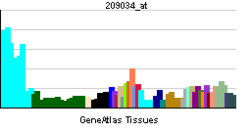PNRC1
| Proline-rich nuclear receptor coactivator 1 | |||||||||||||
|---|---|---|---|---|---|---|---|---|---|---|---|---|---|
| Identifiers | |||||||||||||
| Symbols | PNRC1 ; B4-2; PNAS-145; PROL2; PRR2 | ||||||||||||
| External IDs | OMIM: 606714 MGI: 1917838 HomoloGene: 4960 GeneCards: PNRC1 Gene | ||||||||||||
| |||||||||||||
| RNA expression pattern | |||||||||||||
 | |||||||||||||
| More reference expression data | |||||||||||||
| Orthologs | |||||||||||||
| Species | Human | Mouse | |||||||||||
| Entrez | 10957 | 108767 | |||||||||||
| Ensembl | ENSG00000146278 | ENSMUSG00000040128 | |||||||||||
| UniProt | Q12796 | Q3TWH3 | |||||||||||
| RefSeq (mRNA) | NM_006813 | NM_001033225 | |||||||||||
| RefSeq (protein) | NP_006804 | NP_001028397 | |||||||||||
| Location (UCSC) | Chr 6: 89.79 – 89.79 Mb | Chr 4: 33.25 – 33.29 Mb | |||||||||||
| PubMed search | |||||||||||||
Proline-rich nuclear receptor coactivator 1 is a protein that, in humans, is encoded by the PNRC1 gene.[1][2]
Function
PNRC1 functions as a coactivator for several nuclear receptors including AR, ERα, ERRα, ERRγ, GR, SF1, PR, TR, RAR and RXR.[3][4] The interaction between PNRC1 with nuclear receptors occurs through the SH3 domain of PNRC1.[4]
References
- ↑ Chen J, Liu L, Pohajdak B (Dec 1995). "Cloning a cDNA from human NK/T cells which codes for a protein with high proline content". Biochim Biophys Acta 1264 (1): 19–22. doi:10.1016/0167-4781(95)00159-e. PMID 7578250.
- ↑ "Entrez Gene: PNRC1 proline-rich nuclear receptor coactivator 1".
- ↑ Zhou D, Quach KM, Yang C, Lee SY, Pohajdak B, Chen S (July 2000). "PNRC: a proline-rich nuclear receptor coregulatory protein that modulates transcriptional activation of multiple nuclear receptors including orphan receptors SF1 (steroidogenic factor 1) and ERRalpha1 (estrogen related receptor alpha-1)". Mol. Endocrinol. 14 (7): 986–98. doi:10.1210/me.14.7.986. PMID 10894149.
- ↑ 4.0 4.1 Zhou D, Chen S (October 2001). "PNRC2 is a 16 kDa coactivator that interacts with nuclear receptors through an SH3-binding motif". Nucleic Acids Res. 29 (19): 3939–48. doi:10.1093/nar/29.19.3939. PMC 60244. PMID 11574675.
Further reading
- Gerhard DS, Wagner L, Feingold EA et al. (2004). "The Status, Quality, and Expansion of the NIH Full-Length cDNA Project: The Mammalian Gene Collection (MGC)". Genome Res. 14 (10B): 2121–7. doi:10.1101/gr.2596504. PMC 528928. PMID 15489334.
- Zhou D, Chen B, Ye JJ, Chen S (2004). "A novel crosstalk mechanism between nuclear receptor-mediated and growth factor/Ras-mediated pathways through PNRC-Grb2 interaction". Oncogene 23 (31): 5394–404. doi:10.1038/sj.onc.1207695. PMID 15122321.
- Mungall AJ, Palmer SA, Sims SK et al. (2003). "The DNA sequence and analysis of human chromosome 6". Nature 425 (6960): 805–11. doi:10.1038/nature02055. PMID 14574404.
- Strausberg RL, Feingold EA, Grouse LH et al. (2003). "Generation and initial analysis of more than 15,000 full-length human and mouse cDNA sequences". Proc. Natl. Acad. Sci. U.S.A. 99 (26): 16899–903. doi:10.1073/pnas.242603899. PMC 139241. PMID 12477932.
- Hsiao PW, Chang C (1999). "Isolation and characterization of ARA160 as the first androgen receptor N-terminal-associated coactivator in human prostate cells". J. Biol. Chem. 274 (32): 22373–9. doi:10.1074/jbc.274.32.22373. PMID 10428808.
External links
- PNRC1 protein, human at the US National Library of Medicine Medical Subject Headings (MeSH)
- NURSA C108
| ||||||||||||||||||||||||||||